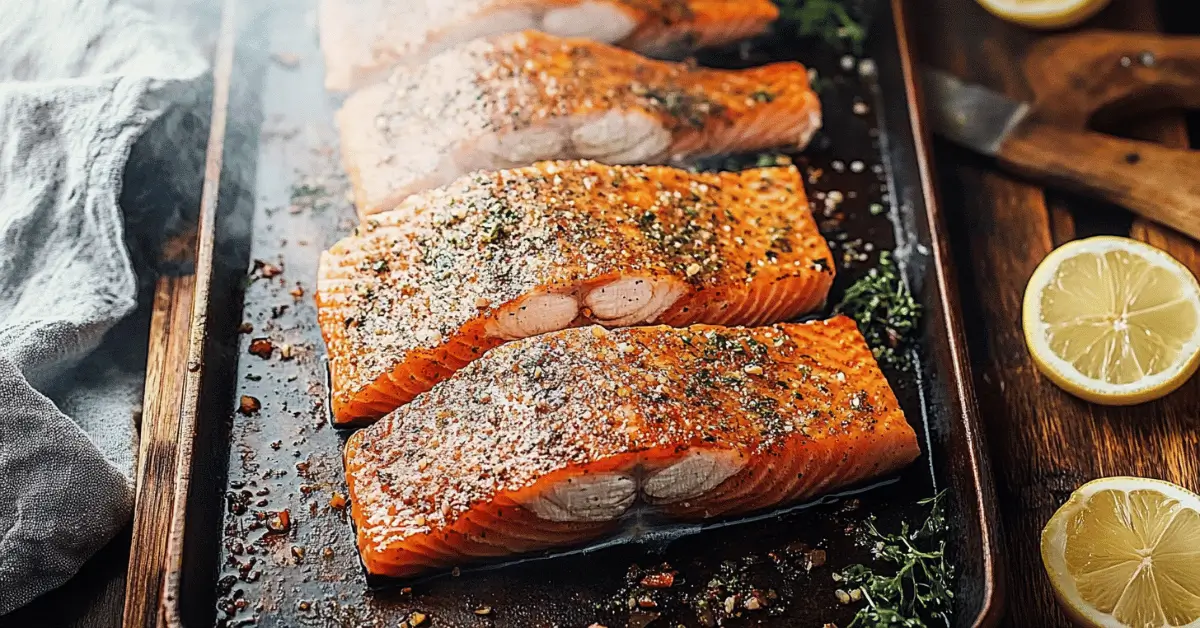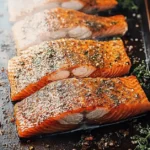If you’re serious about making the best smoked salmon at home, then mastering smoked salmon temperature is your golden ticket. Whether you’re cold-smoking for that silky, rich texture or going the hot-smoking route for flakier, juicy bites, the temperature you use can make or break your salmon. In this comprehensive guide, we’ll explore the science and technique behind the perfect heat levels for smoked salmon. You’ll learn what internal temperature signals that your fish is done, the risks of undercooking or overcooking, the equipment you need, and how smoked salmon can elevate everything from pasta to brunch platters.
Don’t miss our expert guide on how to smoke salmon in a smoker for a hands-on walkthrough.
Jump to:
Understanding Smoked Salmon Types
Hot vs Cold Smoking: Key Differences Explained
To truly grasp why smoked salmon temperature matters, it’s essential to understand the two main smoking methods: hot-smoking and cold-smoking. Cold smoking is all about flavor preservation without actually cooking the fish. The temperature remains between 68°F to 86°F (20°C to 30°C), meaning the salmon stays raw in texture but infused with smoke. Because it’s not heated enough to kill bacteria, cold-smoked salmon relies heavily on the curing process to stay safe.
In contrast, hot-smoking is where things really heat up. The smoker runs between 150°F and 170°F (65°C to 77°C), fully cooking the fish and transforming it into something flaky, safe, and deeply flavorful. The internal smoked salmon temperature here should reach at least 120°F to 135°F for ideal doneness. This method is not only safer for home cooks but also delivers a hearty texture that suits more dishes.
Cold-smoked salmon is best used in recipes where the fish is not reheated, like bagels or canapés. Hot-smoked versions, however, can handle being tossed into warm pasta or scrambled eggs without compromising food safety or taste.
Why Temperature Control is Crucial for Both Methods
Let’s be clear: if you mess up the temperature, you risk either dry, tough salmon or worse—foodborne illness. The smoked salmon temperature for safety and texture must be exact. Undercook it, and you’re left with mushy, unsafe meat. Overdo it, and the salmon turns into a stiff, dry plank.
Cold-smoking demands strict control over the ambient air and cure, especially since the fish is exposed to the “danger zone” (40°F to 140°F) for hours. In this case, only expert curing and low moisture levels make the final product edible. Even then, the U.S. FDA recommends cold-smoking only under strict commercial conditions due to food safety concerns.
Hot-smoking gives you a more forgiving, beginner-friendly path, but you still need to know when to pull the fish. Most pros recommend pulling the fish when the internal smoked salmon temperature hits 120°F to 125°F. This gives you a succulent texture while avoiding the dryness that occurs above 140°F.
Table 1: Smoking Method Temperature Comparison
| Smoking Method | Ambient Temp | Internal Temp | Texture | Safety |
|---|---|---|---|---|
| Cold Smoking | 68°F–86°F | Not cooked | Silky | Risky without cure |
| Hot Smoking | 150°F–170°F | 120°F–135°F | Flaky | Safer |
Discover great ideas like crispy salmon bites in the air fryer if you enjoy different textures and quick cooking methods.
Stay tuned for Part 2, where we’ll break down exactly what internal temperature smoked salmon should reach for safety, flavor, and perfect texture.
Ideal Internal Smoked Salmon Temperature
The Safe Internal Temperature for Hot-Smoked Salmon
When it comes to food safety, hitting the right smoked salmon temperature is more than just culinary preference—it’s a health essential. For hot-smoked salmon, the USDA and most food safety experts recommend cooking fish to an internal temperature of 145°F. However, this number is often too high if you’re aiming for texture and moisture.
That’s why experienced chefs and smoking enthusiasts aim for an internal temperature between 120°F and 135°F. At this range, the salmon is fully cooked but still tender and moist—not dry or flaky to the point of crumbling. Once the smoked salmon temperature hits 120°F, the flesh turns opaque, the proteins begin to firm up, and that signature rich flavor begins to shine.
Here’s a breakdown of how salmon texture changes as internal temperatures rise:
Table 2: Salmon Texture by Internal Temperature
| Internal Temp | Description |
|---|---|
| 100°F | Slick, translucent, undercooked |
| 120°F | Tender, juicy, opaque, rich flavor |
| 130°F | Flaky, moist, protein separates |
| 140°F | Firm, fibrous, starting to dry |
| 145°F+ | Very dry, stiff, flavor loss |
So if your goal is restaurant-quality smoked salmon, aim to pull it from the smoker right at 120°F to 125°F. That internal smoked salmon temperature offers the best of both worlds: food safety and exceptional eating quality.
Check out our salmon bowl recipe to explore how different textures can enhance your plating and flavor combinations.
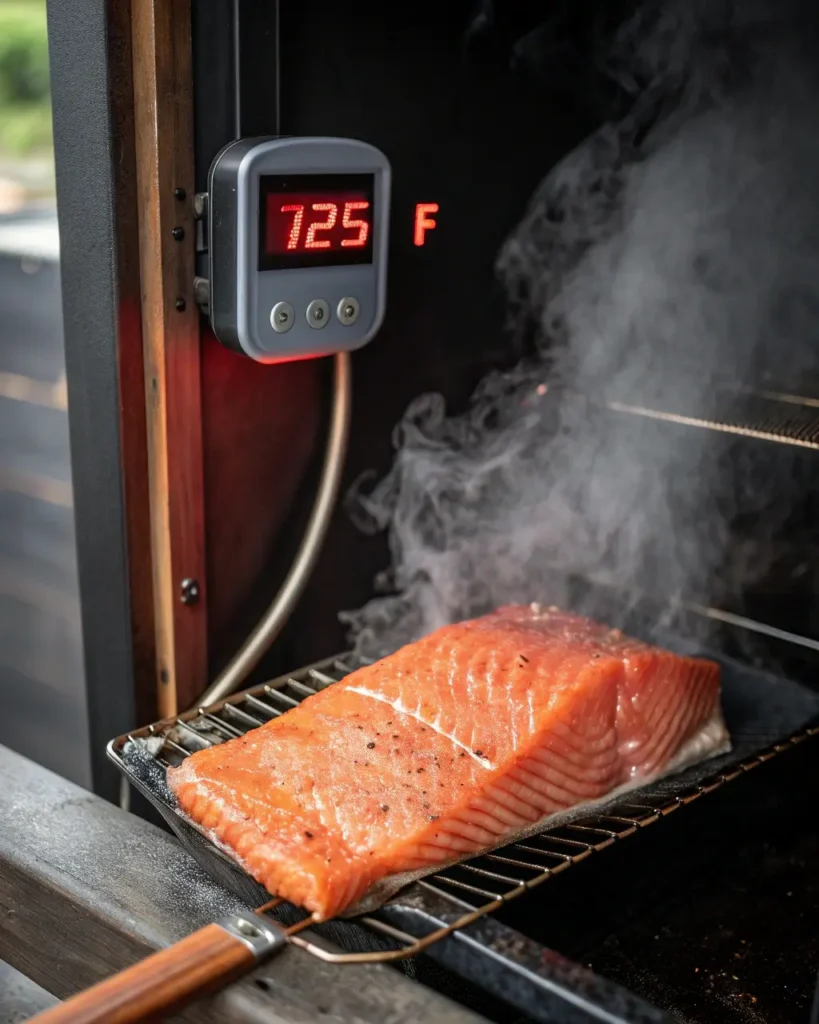
What Happens Inside Salmon at 120°F, 130°F, and 140°F
Fish proteins are delicate, and even a 5-degree difference can change the final bite significantly. Let’s dive into what actually happens inside your salmon at the most critical smoked salmon temperature ranges:
- 120°F (49°C): This is the sweet spot. The myosin (a key protein) begins to gel, creating a slightly firm but juicy texture. The flesh becomes opaque and holds its structure, but it’s still rich and flavorful.
- 130°F (54°C): Now you’re heading into flakier territory. At this point, the muscle fibers start to separate, giving you classic “pull-apart” salmon. It’s still safe, still juicy—but some moisture loss begins here.
- 140°F (60°C): The salmon becomes noticeably firmer and starts to dry out. Collagen turns into gelatin, but the tenderness gives way to chewiness. This is where many people mistakenly overcook their fish.
That’s why understanding the smoked salmon temperature at each milestone is so important. Without a probe thermometer, you’re basically cooking blind. To ensure accuracy, use a high-precision tool like the Thermapen or ThermaQ and insert it in the thickest part of the fillet.
Don’t miss our guide on how long to cook salmon bites in the oven for additional timing tips if you’re not using a smoker.
To wrap this part up: 120°F is your gold standard, but feel free to experiment up to 135°F if you like a firmer bite. Go beyond that, and you’re likely to lose both flavor and texture.
Temperature Ranges for Smoking Salmon
Recommended Smoker Temperatures (Hot Smoking)
For anyone who’s smoked salmon at home, the importance of smoker temperature can’t be overstated. The ideal ambient smoker temperature for hot-smoking salmon is between 150°F and 170°F (66°C–77°C). This range allows for thorough cooking without drying out the fish, and most importantly, it keeps you above the food danger zone.
Keeping the heat steady at 150°F gives the salmon time to absorb smoke deeply while preserving its moisture. That slow rise in smoked salmon temperature helps proteins unfold gradually, preventing that chalky or rubbery texture nobody wants.
What makes this range optimal?
- 150°F–160°F: Ideal for most hot-smoking sessions. Allows internal temp to rise slowly and evenly.
- 160°F–170°F: Slightly faster cook; may firm up the texture more quickly, but you must monitor the salmon closely to avoid drying it out.
- Above 170°F: Avoid unless you’re going for a very dry finish or using thick cuts that require rapid cooking.
The key takeaway? Keep your smoker steady and low, using wood chips like apple or cherry for a mild, aromatic smoke that complements the salmon without overpowering it.
Looking for inspiration? Try our san antonio grilled mexican chicken marinade if you’re exploring other smoker-friendly proteins.
Cold Smoking Temps: Safety Considerations
Cold smoking is a more traditional method, but it comes with higher risk. During cold smoking, the smoker stays between 68°F and 86°F (20°C–30°C), and the fish is not actually cooked. That means all food safety depends on a precise curing process and maintaining the correct environment.
Here are a few cold smoking facts to keep in mind:
- The smoked salmon temperature never exceeds 86°F, so bacteria aren’t killed by heat.
- The fish must be fully cured with a mix of salt and sugar for at least 24 hours before smoking.
- Cold-smoked salmon should only be attempted by experienced cooks with controlled environments.
If you’re new to smoking, it’s best to start with hot-smoking. It’s safer, more forgiving, and still incredibly delicious.
Let’s compare the two again from a temperature perspective:
Table 3: Hot Smoking vs Cold Smoking Overview
| Feature | Hot Smoking | Cold Smoking |
|---|---|---|
| Smoker Temp | 150°F – 170°F | 68°F – 86°F |
| Internal Temp | 120°F – 135°F | Not applicable (raw) |
| Food Safety | High (cooked) | Low (cured, not cooked) |
| Texture | Flaky, moist | Silky, firm |
| Risk Level | Low | High without proper curing |
Don’t miss our how to smoke salmon in a smoker guide for complete steps and timeframes tailored to both smoking styles.
In the next section, we’ll walk you through how to apply these temperatures in a real-world smoking session—from prep to plate.
Step-by-Step Guide to Hot Smoking Salmon
Preparing the Cure and Pellicle Formation
Before your salmon even hits the smoker, two crucial steps lay the foundation for flavor and food safety: curing and pellicle formation.
1. Dry Cure Mix:
Start by combining the following in a bowl:
- 1 cup kosher salt
- ½ cup white sugar
- ½ cup brown sugar
- 1 tablespoon cracked black pepper
Spread half of the mix onto plastic wrap, place your salmon fillet skin-side down, and then cover it with the rest of the cure. Wrap tightly in plastic, then foil, and refrigerate for 24 hours while applying weight on top (a pan with soup cans works well). This draws out moisture and enhances the texture—crucial to controlling your final smoked salmon temperature success.
2. Rinse and Dry:
After curing, rinse the salmon under cold water to remove excess cure, then pat completely dry. Place it on a wire rack over a tray and let it air dry uncovered in the fridge for several hours. This forms the pellicle, a tacky layer that helps smoke cling better and locks in moisture.
Quick Tip: To speed this up, place a small fan in front of the salmon in a cool, dry room. The pellicle should feel slightly sticky and matte when ready.
Looking for inspiration? Try this apple and honey glazed chicken tenders recipe if you’re into sweet-savory protein pairings.
Cooking Time and Internal Temperature Monitoring Tips
Once cured and dried, it’s time to bring the heat. Preheat your smoker to 150°F, and prep your tools.
Equipment checklist:
- Dual-probe thermometer (e.g., ThermaQ or Thermapen)
- Apple or cherry wood chips
- Wire rack or smoker grate
Smoking Steps:
- Place the salmon skin-side down on the smoker grate.
- Insert the probe thermometer into the thickest part of the fillet.
- Maintain your smoker at a steady 150°F.
- Smoke the salmon until it reaches an internal smoked salmon temperature of 120°F to 125°F.
This process usually takes 60 to 90 minutes, depending on fillet size and smoker stability.
Pro Tip: Avoid checking too often. Each time you open the smoker, you lose heat and slow the cook. Use your thermometer’s alarm to know exactly when to check.
Once done, verify the temperature in multiple areas to ensure it’s even throughout. Remember, at 120°F, the proteins are perfectly set, flaky, and juicy. Let the salmon rest for 5 minutes before serving or refrigerating.
Table 4: Salmon Smoking Timeline
| Step | Action | Duration |
|---|---|---|
| Curing | Salt + sugar + weight | 24 hours |
| Pellicle Formation | Air drying in fridge/fan | 4–8 hours |
| Hot Smoking | 150°F smoker temp | 60–90 minutes |
| Internal Temp Target | 120°F–125°F | Until reached |
| Rest Time | After removing from smoker | 5–10 minutes |
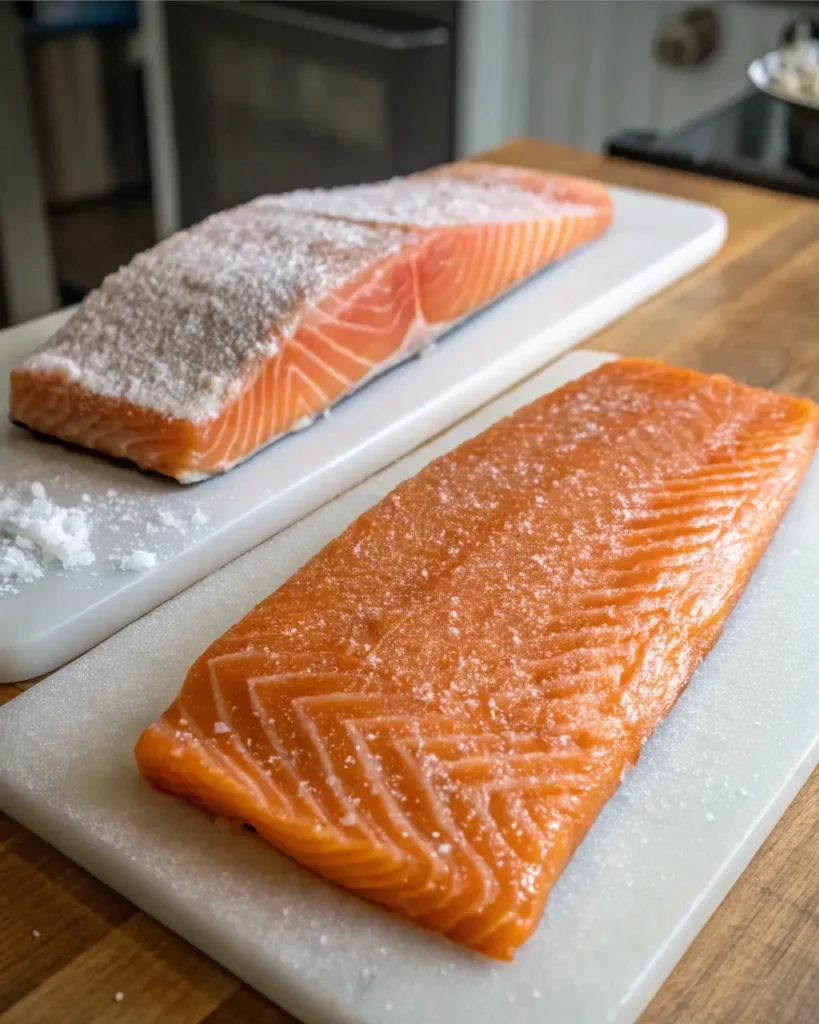
Don’t miss our baked salmon bites recipe if you want a quicker oven alternative for smoky salmon flavor.
In the next section, we’ll review the best tools for managing smoker and internal salmon temperatures with precision and ease.
Tools for Tracking Smoked Salmon Temperature
Best Thermometers for Smoking (ThermaQ, Thermapen)
When it comes to nailing the perfect smoked salmon temperature, guessing just won’t cut it. Precision matters. That’s why a high-quality thermometer isn’t optional—it’s essential.
Two of the best tools for the job are the ThermaQ and the Thermapen, both loved by pitmasters and chefs for their accuracy and reliability.
1. ThermaQ Dual-Probe Thermometer
The ThermaQ is perfect for smoked salmon because it monitors both your smoker’s ambient temperature and the internal temp of the salmon simultaneously. With high/low alarms, you’ll know if your smoker strays from the ideal 150°F–170°F range—critical for maintaining proper smoked salmon temperature.
ThermaQ Benefits:
- Dual-channel (smoker + meat)
- Programmable temp alarms
- Industrial-grade thermocouple sensors
- Accurate to ±0.7°F
2. Thermapen One (Instant Read)
This handheld thermometer gives you ultra-fast spot checks with a reading time of just 1 second. It’s especially useful toward the end of the smoke session, to verify the internal smoked salmon temperature across multiple points before pulling the fish off the heat.
Thermapen Perks:
- 1-second read time
- High-precision sensor
- Auto-rotating display
- Waterproof and rugged
Even if you’re smoking fish only occasionally, investing in a trusted thermometer will give you consistent results and ensure you never over- or under-cook your salmon again.
Check out our guide to smoking cream cheese at 250°F if you’re experimenting with other smoked appetizers.
Using Probes to Monitor Smoker and Fish Simultaneously
A big mistake beginners make? Measuring smoker temperature but ignoring the salmon’s internal temperature—or vice versa. To get this right, your thermometer needs two probes:
- Probe 1: Inserted horizontally into the thickest part of the salmon fillet. This is your real-time gauge for internal smoked salmon temperature.
- Probe 2: Clipped just above the smoker grate, tracking the ambient cooking environment.
How to Set It Up Properly:
- Preheat your smoker to 150°F.
- Clip the ambient probe in the center of the smoking chamber.
- Insert the meat probe into the thickest part of your salmon fillet.
- Set your low/high smoker alarms (140°F low, 160°F high).
- Set your salmon probe alarm to 120°F or 125°F, depending on desired doneness.
With this setup, you’ll maintain a tight control loop throughout the cook—essential for perfect smoked salmon temperature and texture.
Table 5: Temperature Probe Placement Tips
| Probe Type | Placement Location | Purpose |
|---|---|---|
| Ambient Probe | Clipped to smoker grate | Tracks smoker temp consistency |
| Meat Probe | Center of salmon fillet | Monitors internal temp |
If you want your gear to be as dialed-in as your recipes, these tools are a must. Without accurate readings, even the best technique can’t guarantee great results.
Looking for more flavor-forward smoker recipes? Don’t miss our bold creative smoked cream cheese ideas.
Up next: we’ll dive into Part 6: Common Mistakes with Smoked Salmon Temperature and how to avoid them like a pro.
Common Mistakes with Smoked Salmon Temperature
Overcooking and Dry Texture Problems
One of the biggest letdowns in home smoking? Cutting into your fish and finding it’s bone-dry. This often stems from exceeding the ideal smoked salmon temperature range.
When internal temps rise above 135°F, salmon begins to lose its natural oils and moisture. The texture becomes flaky, then fibrous, and eventually brittle. While USDA guidelines suggest 145°F for cooked fish, most smoking experts agree that’s simply too high for flavor retention and texture.
Key signs of overcooked smoked salmon:
- Dull, chalky color
- Stringy or stiff bite
- Loss of natural sheen
- Dry mouthfeel, lacking oils
Here’s the truth: Salmon continues to cook slightly after removing it from the smoker. That’s why pulling it at 120°F–125°F allows a short carryover rise while keeping moisture intact. You want juicy, not jerky.
If you’re cooking other meats too, check out our porterhouse steak guide for temp-specific cooking tips that translate beautifully to all proteins.
How to Prevent Undercooked or Unsafe Salmon
On the flip side, undercooking is a common problem for those afraid of drying out their fish. While salmon can be enjoyed medium-rare when pan-seared, smoking requires a different mindset—because we’re dealing with low-and-slow heat over a longer time.
Pulling your fish below 120°F internal smoked salmon temperature puts you at risk. Proteins may still be translucent, the texture slick, and bacteria may not be fully neutralized. If your salmon feels too soft or looks raw inside, it probably is.
Avoid undercooking by:
- Always using a digital thermometer
- Monitoring the smoker’s ambient temperature
- Cooking until the thickest part reaches at least 120°F
- Spot-checking multiple areas before calling it “done”
Remember: it’s not just about flavor—it’s about food safety. Especially with fish, precision matters.
Table 6: Smoked Salmon Cooking Issues & Fixes
| Mistake | Cause | Fix |
|---|---|---|
| Dry texture | Temp too high (>135°F) | Pull at 120°F–125°F, rest properly |
| Undercooked inside | Pulled too early (<115°F) | Use probe thermometer, wait till 120°F |
| Uneven cooking | Cold spots in smoker or fillet | Check smoker layout & flip fillet if needed |
| Weak smoke flavor | Pellicle not formed or short cook | Dry longer, extend smoking time |
Looking for other flavorful protein dishes that avoid dryness? Don’t miss our cheesy chicken sloppy joe recipe, packed with juicy texture and perfect for family dinners.
By avoiding these common missteps, you’ll ensure every batch of smoked salmon hits the mark—not just in taste, but also in safety and satisfaction.
Up next: Let’s explore how to enhance flavor while managing smoked salmon temperature for maximum payoff.
Enhancing Flavor While Managing Temperature
Wood Choices for Smoking and Their Effects
When we talk about elevating your smoked salmon, flavor starts with wood. Choosing the right wood chips is just as important as maintaining the correct smoked salmon temperature.
Each type of wood infuses the salmon with its own unique aroma and taste, and some woods can overpower the fish if the balance isn’t right. Lighter woods are ideal for salmon because they impart a clean, mild flavor that complements rather than masks the fish.
Best Wood Types for Smoked Salmon:
- Applewood: Mild and fruity, ideal for soft, delicate salmon fillets.
- Cherry: Slightly sweet, adds a beautiful color and balanced smoke.
- Alder: Traditional for salmon, subtle, earthy, and neutral.
- Maple: Mildly sweet, enhances the fish’s natural richness.
Avoid mesquite or hickory—these woods are too strong and can dominate the taste.
Here’s the kicker: no matter what wood you choose, controlling your smoked salmon temperature ensures that those flavors actually absorb without burning or drying the fish. Too hot, and the smoke becomes bitter. Too cold, and the fish stays raw or flavorless.
Looking for a sweet-savory pairing to go with your smoked salmon? Try our sugar-free caramel syrup drizzled over crispy rye toast and cream cheese for a brunch twist.
Balancing Smoke Intensity with Correct Heat Levels
It’s not just about what flavor goes into the smoker—it’s about how it gets in. Managing both the quantity of smoke and the smoked salmon temperature is what creates that perfect bite.
If your smoker runs too hot, the wood combusts rapidly, producing thick, acrid smoke that clings aggressively to the salmon. On the flip side, if the smoker isn’t hot enough (under 140°F), the wood may smolder ineffectively, leading to underwhelming flavor and potential food safety issues.
Smoke Intensity Tips:
- Keep smoker temp steady at 150°F–160°F
- Use a small handful of wood chips at a time
- Replenish every 30–45 minutes for consistent output
- Make sure vents are open for clean-burning oxygen flow
Don’t overload the smoker with wood—this can choke the air and produce a heavy, bitter taste. It’s all about moderation. Clean, blue smoke is your friend. Thick, white smoke is your enemy.
Table 7: Smoke Flavor Control Chart
| Factor | Ideal Condition | Risk if Mismanaged |
|---|---|---|
| Smoker Temp | 150°F–160°F | Over 170°F = bitter smoke |
| Wood Quantity | Small handful, refilled | Too much = acrid taste |
| Smoke Color | Light blue, transparent | White/gray = dirty smoke |
| Airflow | Steady with open vents | Low = incomplete combustion |
Looking for inspiration? Pair smoked salmon with our earl grey cookies for a unique, elegant brunch menu.
As we move into the next section, you’ll learn exactly how to apply all of this in mouthwatering recipes using perfectly smoked salmon.
Recipes Using Smoked Salmon at the Right Temp
Easy Pasta with Hot-Smoked Salmon
Once you’ve nailed the perfect smoked salmon temperature, it’s time to put your flavorful fish to work in recipes. First up? A creamy, comforting smoked salmon pasta dish that’s as easy as it is impressive.
Hot-Smoked Salmon Pasta (serves 2–3):
Ingredients:
- 8 oz fettuccine or linguine
- 1 cup heavy cream
- 2 tablespoons grated Parmesan
- 1 tablespoon lemon juice
- 1 teaspoon black pepper
- ½ teaspoon garlic powder
- 4 oz hot-smoked salmon (pulled at 125°F)
- Fresh parsley (for garnish)
Instructions:
- Boil pasta in salted water until al dente; drain and set aside.
- In a pan, heat the cream over low heat. Add garlic powder, black pepper, and Parmesan. Stir until combined.
- Fold in the smoked salmon (pre-cooked to correct smoked salmon temperature) and lemon juice.
- Toss pasta into the sauce, stir gently to coat, and cook for another 1–2 minutes.
- Serve warm with parsley and extra cheese.
This recipe benefits from the moist, flake-apart texture achieved by maintaining internal temps around 120°F–125°F—any higher, and the salmon would fall apart or turn dry in the sauce.
Looking for a hearty companion dish? Try our steak pasta recipe for a surf-and-turf spin on classic comfort food.
Smoked Salmon Bagel Brunch Bowl
Hot-smoked salmon also shines cold, especially after resting overnight in the fridge, where the smoky flavor sets. This bagel bowl brings freshness, texture, and satisfying balance.
Smoked Salmon Brunch Bowl (serves 1):
Ingredients:
- 1 everything bagel, sliced
- 2 oz hot-smoked salmon (pre-cooked to 122°F)
- ¼ cup whipped cream cheese
- Sliced red onion
- ½ avocado, sliced
- Capers
- Fresh dill
- Lemon wedge
Instructions:
- Toast bagel slices and spread each with cream cheese.
- Layer on smoked salmon, red onion, avocado, and capers.
- Sprinkle fresh dill, squeeze lemon over the top, and serve with a side of greens or cucumber salad.
Because the salmon was carefully smoked to the ideal smoked salmon temperature, its texture is smooth, meaty, and flavorful—perfect for eating cold without reheating.
This dish is great for make-ahead brunches, holiday platters, or next-day meals from your smoking session.
Want to explore more cozy comfort dishes? Don’t miss our hamburger potato soup for a hearty addition to your weekend menu.
Table 8: Recipe Cooking Summary
| Recipe | Internal Temp Used | Flavor Profile | Best For |
|---|---|---|---|
| Smoked Salmon Pasta | 125°F | Creamy, savory | Dinner or lunch |
| Smoked Salmon Bagel Bowl | 122°F | Smoky, cold, zesty | Brunch or light meal |
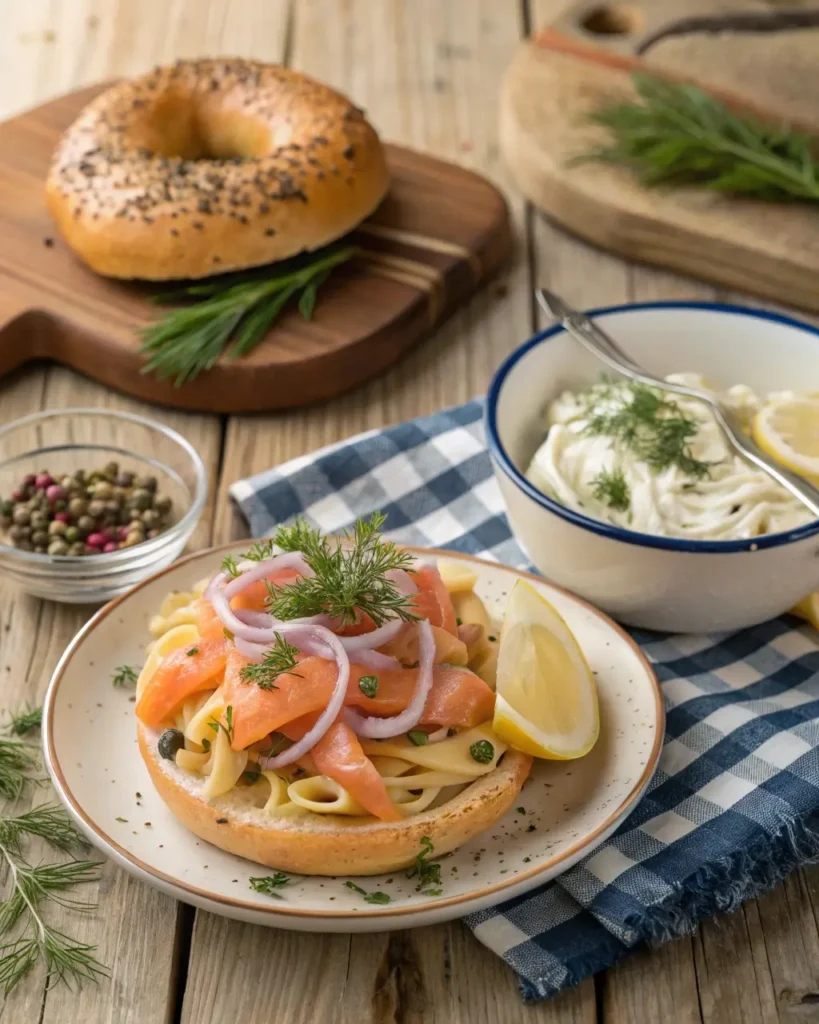
Coming up next: how to store and reheat smoked salmon safely without sacrificing flavor or texture.
Smoked Salmon Storage and Reheating Temps
Storing Hot-Smoked Salmon Safely
After putting in all that work to perfect your smoked salmon temperature, proper storage is key to preserving texture, taste, and food safety. Smoked salmon, especially hot-smoked, can last for several days in the fridge when stored correctly.
Refrigerator Storage Guidelines:
- Let the salmon cool completely at room temperature for no more than 1 hour after smoking.
- Wrap it tightly in plastic wrap or foil to prevent air exposure.
- Store in an airtight container in the coldest part of your fridge, ideally below 40°F.
- Use within 3–4 days for best quality.
For longer storage, you can freeze it—but be warned, freezing can slightly change the texture. To minimize this, vacuum seal your salmon or wrap it in parchment paper before freezing in a zip-top bag. Consume within 2–3 months for best results.
Explore another great make-ahead option like our protein donuts if you’re meal prepping your smoked salmon for busy weeks.
How to Reheat Without Overcooking
Reheating smoked salmon can be tricky. If you’re not careful, the delicate balance achieved through controlled smoked salmon temperature can be ruined. You don’t want to overcook or dry it out—especially if your salmon was smoked to 120°F.
Here are your best reheating options:
1. Gentle Oven Reheat (Recommended)
- Preheat oven to 275°F
- Wrap the salmon in foil with a splash of lemon or olive oil
- Heat for 10–12 minutes, until warm but not hot
- Internal temperature should stay under 135°F
2. Stovetop Steam Reheat
- Place a steaming basket over boiling water
- Cover and steam salmon for 3–5 minutes
- This method retains moisture and minimizes temp spikes
3. Skip Reheating
For dishes like salads, grain bowls, or brunch platters, skip reheating altogether. Thanks to precise smoked salmon temperature during prep, the fish is flavorful and safe to eat cold.
Table 9: Smoked Salmon Storage & Reheat Summary
| Storage/Reheat Method | Best Practice | Risk if Misused |
|---|---|---|
| Refrigerator | 3–4 days, wrapped airtight | Spoilage, odor if left too long |
| Freezer | Up to 3 months (vacuum-sealed) | Texture loss if not sealed well |
| Oven Reheat | 275°F for 10 mins, low temp | Overcooking above 135°F |
| Stovetop Steam | 3–5 mins, indirect heat | Waterlogging if oversteamed |
Looking for another great storage-friendly recipe? Don’t miss our protein cookie dough—a great make-ahead treat that’s easy to refrigerate or freeze.
Now that you know how to store and reheat smoked salmon properly, let’s move into the FAQ section to clear up some of the most common questions home cooks have.
Frequently Asked Questions About Smoked Salmon Temperature
Can you eat smoked salmon at 130 degrees?
Yes, absolutely. An internal smoked salmon temperature of 130°F is considered safe and ideal for hot-smoked salmon. At this point, the fish is cooked through, opaque, and starts to flake gently. It’s a sweet spot where you still retain juiciness without risking raw texture. Most smoking enthusiasts pull it even slightly earlier (at 120°F–125°F) to avoid dryness, but 130°F is within the acceptable range for both safety and flavor.
Can I put smoked salmon in pasta?
Definitely—and it’s delicious. In fact, adding smoked salmon to pasta is one of the most popular ways to enjoy it. The key is using hot-smoked salmon that’s been properly cooked to an internal smoked salmon temperature of 120°F to 125°F. That ensures the fish won’t overcook when added to warm sauces. Gently fold it into the dish just before serving to maintain its flakiness and rich, smoky flavor.
Looking for a pasta idea? Don’t miss our steak pasta recipe which you can modify with smoked salmon.
What temperature should salmon be pulled?
Pull your smoked salmon when it reaches an internal temperature of 120°F to 125°F. This is the sweet zone where the flesh turns opaque and begins to flake without drying out. If you’re targeting the most succulent texture, 120°F is ideal. Let it rest briefly off the heat to allow minimal carryover cooking—this keeps the final smoked salmon temperature controlled and consistent.
How do you tell if smoked salmon is done?
Smoked salmon is done when it reaches an internal temperature of 120°F to 130°F, depending on your preferred texture. Visually, it will look opaque, firm yet tender, and flake easily with a fork. You’ll also notice it has a rich pink hue from the smoke and an even, cooked texture throughout. Always use a meat thermometer—guessing based on looks alone can lead to under- or overcooked results.
Check out our how to smoke salmon in a smoker guide for step-by-step visuals and temperature checkpoints.
Is it okay to eat salmon at 135?
Yes, 135°F is still safe and quite common for those who like a firmer, drier texture. That said, going beyond 135°F risks drying out the fish. You’re best off sticking to 120°F to 130°F if you want moisture and tenderness. At 135°F, the smoked salmon temperature has caused most proteins to fully set, making it perfect for crumbling over salads or folding into grain bowls.
What internal temp is smoked salmon done?
For hot-smoked salmon, the internal smoked salmon temperature should hit 120°F to 135°F. This range gives you flexibility to choose between moist and flaky textures. At 120°F, your salmon will be soft, juicy, and rich. At 135°F, it becomes firmer and a little drier, but still flavorful. For cold-smoked salmon, remember the fish isn’t cooked by temperature—it’s cured and smoked at lower ambient temps (68°F–86°F).
Want more dinner flexibility? Try pairing smoked salmon with our summer sausage for a unique smoked charcuterie combo.
Conclusion: Master the Art of Smoked Salmon Temperature
If there’s one thing we’ve made clear, it’s this: mastering your smoked salmon temperature is the foundation of unforgettable flavor, texture, and food safety. Whether you’re smoking for the first time or refining your BBQ technique, staying within that 120°F to 125°F internal range is the difference between bland and brilliance.
From choosing the right wood chips to knowing when to pull your fillet, every step matters. The right smoked salmon temperature preserves natural oils, enhances smoke absorption, and delivers a firm-yet-juicy bite every time. Now that you know how to smoke, store, reheat, and serve smoked salmon like a pro—you’re ready to impress at any meal.
Don’t miss our full step-by-step guide on smoking salmon if you’re ready to fire up the smoker this weekend.
PrintSmoked Salmon Temperature: The Key to Perfect Smoking
Learn how to achieve perfectly smoked salmon every time with this comprehensive guide. Whether you’re cold-smoking for a silky texture or hot-smoking for a flaky finish, mastering the ideal temperature is key. Follow these easy steps for flavorful, tender smoked salmon that’s perfect for any occasion.
- Prep Time: 12 hours (includes brining and drying)
- Cook Time: 3–4 hours
- Total Time: 15–16 hours
- Yield: 4 servings
- Category: Seafood
- Method: Smoking
- Cuisine: American
- Diet: Gluten Free
Ingredients
- Brine:
- 1 cup kosher salt
- 1 cup brown sugar
- 4 cups water
- Optional: 2 tbsp fresh dill, zest of 1 lemon, 2 crushed garlic cloves
- Salmon:
- 1–2 pounds salmon fillets (skin-on)
- For Smoking:
- Wood chips (e.g., alder, hickory, or applewood)
Instructions
- Prepare the Brine: In a large bowl, dissolve the salt and sugar in water. Add optional flavorings for a customized brine.
- Brine the Salmon: Submerge the salmon in the brine and refrigerate for 8–12 hours.
- Dry the Salmon: Remove the salmon, rinse thoroughly under cold water, and pat dry. Place on a rack and let it air-dry for 1–2 hours to form a pellicle.
- Set Up the Smoker: Preheat your smoker to the desired temperature:
- Cold-smoking: 70–90°F
- Hot-smoking: 120–150°F
- Add Wood Chips: Add your chosen wood chips to the smoker for flavor.
- Smoke the Salmon: Place the salmon fillets in the smoker:
- Cold-smoking: Smoke for 6–8 hours.
- Hot-smoking: Smoke for 3–4 hours or until the internal temperature of the salmon reaches 145°F.
- Serve or Store: Once smoked, allow the salmon to cool. Serve immediately or refrigerate for up to 5 days.
Notes
- For cold-smoking, monitor the smoker temperature closely to prevent it from exceeding 90°F.
- Use a digital thermometer to check the salmon’s internal temperature for accuracy.
- Pair your smoked salmon with cream cheese, bagels, or pasta for versatile dishes.

